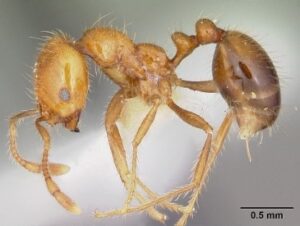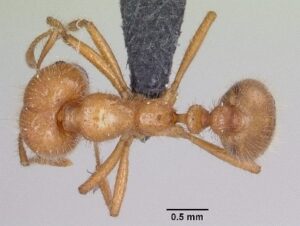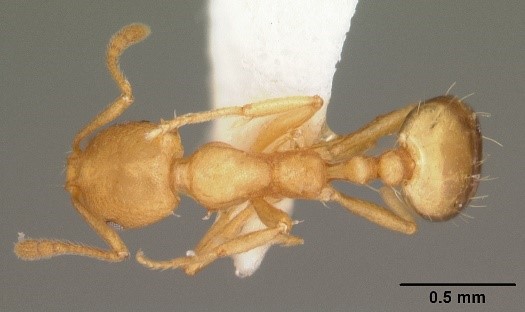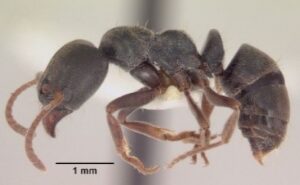Pharaoh ant – Monomorium pharaonis (Linneaus)
General Description
 |
 |
 |
Credit: April Nobile / AntWeb.org
- Workers are 0.5 mm – 2 mm Males are 2-3mm long and queens are about 4-6 mm long with a dark reddish color.
- The head and thorax are dull yellowish to orange to reddish brown.
- Shiny, darker-colored abdomen, especially at the tip.
- They have 12 segmented antennae with a three-segmented club.
- Petiole with two nodes.
- Lacks spines on the back side of the thorax.
- Body has very sparse (light) pubescence
Life Cycle and Common Characteristics
- The eggs, once laid take about 5-6 days to become a larva.
- Larval instars take 22-24 days to reach a prepupal stage, which lasts for 2-3 days, after which the pupa is converted to
- The pavement ant can complete its life cycle within 38-45 days.
- Queens can produce 400 or more eggs in batches of 10 to
- Queens can live four to 12 months, while males die within three to five weeks after mating.
- Pharaoh ants form large colonies made up of multiple nests and multiple queens. They are active year-round indoors and can reproduce at any time of the year.
- The ideal temperature and site for development are 26 to 30°C with a relative humidity of 80 % near sources of food and/or water, such as in wall voids, under floors, behind baseboards, windowsills, kitchens, sinks, and heating
- Pharaoh ants can form new nests at any time of the year.
- Nests may be in wall voids, beneath floors, in cabinets or drawers, or in stacks of paper or linens.
- An individual colony normally contains 1,000–2,500 workers but a high density of nests gives the impression of massive
- Colonies also lack nestmate recognition so there is no hostility between neighboring colonies, which is known as
- They can forage a considerable distance from the nest searching for a wide range of foods, including sweets, meats, fats, and liquid materials.
- A stinger is present but is rarely exerted (thrust outward).
- The Pharaoh ant is polygynous, meaning its colonies contain many
Damage and Economic & Medical Implications
- The Pharaoh ant is a notorious nuisance
- It is closely associated with humans and usually makes its nest in well-hidden crevices in warm areas of public buildings, including schools, office buildings, and hospitals.
- They feed on a wide variety of foods including jellies, honey, shortening, peanut butter, corn syrup, fruit juices, baked goods, soft drinks, grease, dead insects, toothpaste, and even shoe They can also gnaw holes in silk, rayon, and rubber goods.
- It is also known to feed on blood, medical wastes, intravenous feeding fluids, and biological cultures, making it a potentially serious pest in healthcare facilities.
- This ant has been shown to transmit a number of pathogens and is of great concern in hospitals and other healthcare facilities where it has become a difficult but important ant to control.
- Due to its habit of colony multiplication by budding, areas with repeated / residual application may lead to the development of various satellite colonies and infestation may spread over an entire



